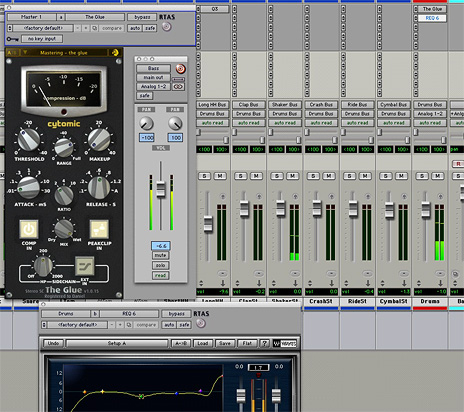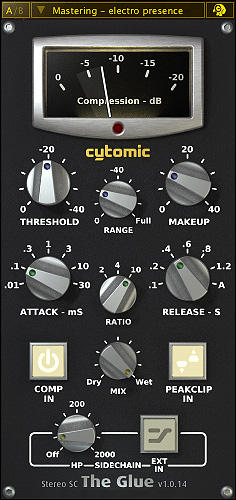- Solid State Logic claim that more platinum records have been made on their SSL 4000 console than on all other mixing desks combined. Although it included a number of technical innovations when it was introduced, it's the stereo bus compressor that was most important in producing the sound that's so desired by engineers. Its twin VCA design meant that it was functionally useful, being quick enough to control dynamics ably and with plenty of gain reduction, but as with all the most coveted studio gear, its individual character made it so ubiquitous. With a mildly aggressive tone that suggested it was just about to distort, it had an ability to "glue" the mix together, with the talk going that you strap one of these across your output bus, and it sounds like a hit.
Cytomic's The Glue aims to replicate this divine device in software. With an analogue modelling approach, the original's pivotal circuit components have been analysed and then replicated mathematically to preserve the original character. There are two main differences. The first will be familiar to computer-based producers: It won't cost you a year's salary to get your hands on one. The second? Features. The original only included the basic ratio, threshold, attack, release and makeup gain controls.
The Glue has augmented the original by increasing the threshold and makeup gain range, as well as including a .01 ms attack time (whereas the shortest time for the original and all the other versions is .1) and adding more release settings within the same range. There's also a "peakclip in" button, which inserts a kind of soft knee limiter at the end of the signal chain, allowing you to tame unruly peaks that might have been created by the compressor. A mix knob is included as well, which provides an easy way to achieve parallel compression.
The unit's versatility is exemplified best, though, in its sidechain section, which can take an external signal (for example, a kick drum if you want to pump a mix or bassline) or can high pass filter the main signal and let the unit react only to high frequencies. This lets you reduce the action of the lower frequencies, which has practical uses like reducing pumping, or more creative effects, the extent of which can be controlled by the filter frequency. The most interesting addition, however, is the range knob, which provides a ceiling to the compression range. It allows you to treat the main body of your sounds, but leave the peaks alone, while treating them gently at the same time, rather than missing them completely as you would with a long attack setting.
 The flipside to the lower cost in ye olde "analogue vs digital" debate is that some say that you simply can't replicate the character of hardware properly in software. The Glue, however, manages to achieve very similar results to Duende and Univeral Audio's versions/recreations/emulations of the SSL 4000. In particular, it succeeds in delivering a crisp punch on hits. That said, it sometimes seems too clean and transparent, with less thickness and saturation than Duende. On full mixes as well, it takes quite a clinical approach; you have to really push it to get it to distort. This makes it very difficult to misuse, to over-process the mix, but on the other hand the "strap on and go" characteristic isn't so prominent.
This is the first plugin by the new Cytomic company, and it's likely that the actual sound of the devices will improve as the company develops, although it's not far shy of its competitors at the moment. What they've done, though, is taken an analogue classic and translated it into a versatile creative tool, and whereas audiophiles might want to pay extra to get closer to the SSL 4000's qualities, the advantages of both price and functionality will more than compensate this for most bedroom producers.
Ratings:
COST: 4.5/5
BUILD: 4/5
VERSATILITY: 4.5/5
EASE OF USE: 4/5
SOUND: 3.5/5
The flipside to the lower cost in ye olde "analogue vs digital" debate is that some say that you simply can't replicate the character of hardware properly in software. The Glue, however, manages to achieve very similar results to Duende and Univeral Audio's versions/recreations/emulations of the SSL 4000. In particular, it succeeds in delivering a crisp punch on hits. That said, it sometimes seems too clean and transparent, with less thickness and saturation than Duende. On full mixes as well, it takes quite a clinical approach; you have to really push it to get it to distort. This makes it very difficult to misuse, to over-process the mix, but on the other hand the "strap on and go" characteristic isn't so prominent.
This is the first plugin by the new Cytomic company, and it's likely that the actual sound of the devices will improve as the company develops, although it's not far shy of its competitors at the moment. What they've done, though, is taken an analogue classic and translated it into a versatile creative tool, and whereas audiophiles might want to pay extra to get closer to the SSL 4000's qualities, the advantages of both price and functionality will more than compensate this for most bedroom producers.
Ratings:
COST: 4.5/5
BUILD: 4/5
VERSATILITY: 4.5/5
EASE OF USE: 4/5
SOUND: 3.5/5 Tracklist- Mac OSX Universal Binary Effect: VST, RTAS, Audio Unit
- Windows Effect: VST, (RTAS version coming soon)

 The flipside to the lower cost in ye olde "analogue vs digital" debate is that some say that you simply can't replicate the character of hardware properly in software. The Glue, however, manages to achieve very similar results to Duende and Univeral Audio's versions/recreations/emulations of the SSL 4000. In particular, it succeeds in delivering a crisp punch on hits. That said, it sometimes seems too clean and transparent, with less thickness and saturation than Duende. On full mixes as well, it takes quite a clinical approach; you have to really push it to get it to distort. This makes it very difficult to misuse, to over-process the mix, but on the other hand the "strap on and go" characteristic isn't so prominent.
This is the first plugin by the new Cytomic company, and it's likely that the actual sound of the devices will improve as the company develops, although it's not far shy of its competitors at the moment. What they've done, though, is taken an analogue classic and translated it into a versatile creative tool, and whereas audiophiles might want to pay extra to get closer to the SSL 4000's qualities, the advantages of both price and functionality will more than compensate this for most bedroom producers.
Ratings:
COST: 4.5/5
BUILD: 4/5
VERSATILITY: 4.5/5
EASE OF USE: 4/5
SOUND: 3.5/5
The flipside to the lower cost in ye olde "analogue vs digital" debate is that some say that you simply can't replicate the character of hardware properly in software. The Glue, however, manages to achieve very similar results to Duende and Univeral Audio's versions/recreations/emulations of the SSL 4000. In particular, it succeeds in delivering a crisp punch on hits. That said, it sometimes seems too clean and transparent, with less thickness and saturation than Duende. On full mixes as well, it takes quite a clinical approach; you have to really push it to get it to distort. This makes it very difficult to misuse, to over-process the mix, but on the other hand the "strap on and go" characteristic isn't so prominent.
This is the first plugin by the new Cytomic company, and it's likely that the actual sound of the devices will improve as the company develops, although it's not far shy of its competitors at the moment. What they've done, though, is taken an analogue classic and translated it into a versatile creative tool, and whereas audiophiles might want to pay extra to get closer to the SSL 4000's qualities, the advantages of both price and functionality will more than compensate this for most bedroom producers.
Ratings:
COST: 4.5/5
BUILD: 4/5
VERSATILITY: 4.5/5
EASE OF USE: 4/5
SOUND: 3.5/5